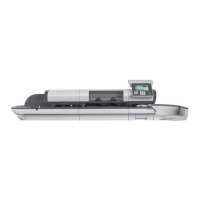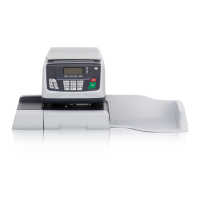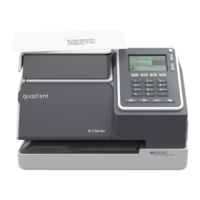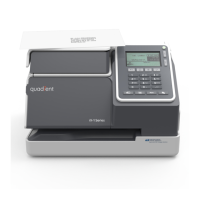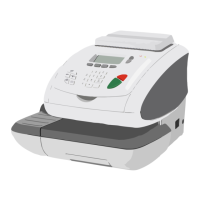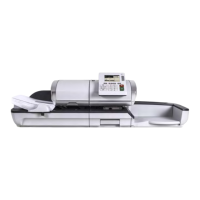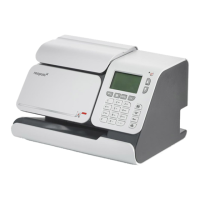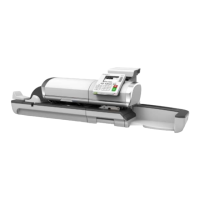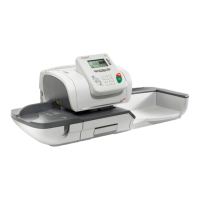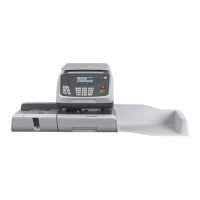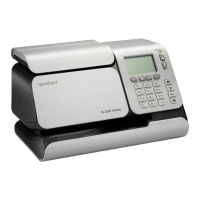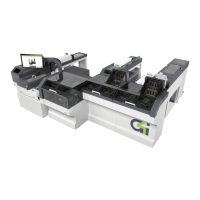Do you have a question about the quadient iX-7PRO Series and is the answer not in the manual?
Details on power connection, grounding, and general safety precautions for office equipment.
Instructions on how to enable the emergency stop function to immediately halt the system.
Explanation of the symbols used in the manual to indicate warnings, attention, notes, and tips.
Overview of the mailing system components and their functions, with diagrams.
Description of optional accessories like USB keyboard, remote label dispenser, and report printer.
Detailed explanation of the display areas and keys on the mailing system's control panel.
Information on the various connectors for peripherals and power on the mailing system base.
Details on Energy Star compliance and how to manage the system's power states (sleep/soft off).
Steps for efficiently running mail, including sorting, logging in, and selecting stamp types.
Guide to selecting the appropriate stamp type based on the mail processing requirements.
Step-by-step instructions for various mail processing scenarios like adding insurance and standard mail.
Procedures for setting postage and processing mail using the permit mail function.
Instructions for correcting postage amounts or dates on mail pieces after stamping.
Configuration options for rates, permits, and imprint tests for customizing mail processing.
Procedures for advanced tasks like resetting batch counters and filling the label dispenser.
Settings for configuring stamp elements like date, text, slogan, and print offset.
Creating, editing, and using imprint memories to save and recall custom stamp configurations.
Introduction to the Postal Security Device (PSD) and its role in handling postage funds.
Procedures for checking PSD funds and adding funds to the postage meter.
Instructions on how to perform a postal inspection call to unlock the system.
Setting up warnings for low funds and configuring the low-funds threshold amount.
Configuring warnings for high postage amounts to prevent accidental printing.
Setting or canceling a funding PIN code to control access to adding postage.
Information on generating postage refill reports, including adding postage and funds summary.
Introduction to postage tracking and access control features, including account modes.
Functionality for setting PIN codes to protect the system and restrict fund usage.
Explanation of different account modes: Account, Account with PIN Code, No Account, No Account with Access Control.
Procedures for creating, viewing, editing, activating/deactivating, and deleting accounts.
Detailed steps on how to create a new account, including number, name, status, and folder.
Settings and procedures for managing groups or subgroups of accounts for operators.
Instructions for exporting and importing account lists using CSV files.
Creating, modifying, and assigning accounts to operators, along with managing their access.
Generating reports related to account usage, operator activity, and system configurations.
Enhancements for account management and detailed reports on budget consumption and operator activity.
Procedure to change the currently active account for cost allocation.
Information on displaying rate tables and downloading new postal rate updates.
Guide to selecting postal rates, including using shortcut lists and the rate wizard.
Steps to generate various reports, choosing display/record options like screen or USB key.
Details on available reports such as Account Report, Batch Data Report, and Daily Usage Report.
Information on additional reports like Budget Consumption and Operator Activity when Advanced Reporting is active.
Explanation of Online Services features: reporting, eConfirmation, rate updates, ink alerts, remote diagnostics.
Details on automatic and manual calls to the Online Server for data updates and feature activation.
Procedures for performing Ping Server and Test Server diagnostic tests to check connectivity.
Overview of system-level online services including Ink Management and Rate Protection.
Capturing and processing USPS confirmation service tracking label numbers.
Description of user settings and supervisor settings for system configuration.
Instructions on how to log in and out of supervisor mode to access system configurations.
Adjusting display brightness, language, and enabling/disabling beeps for user preferences.
Configuration of system time-outs for motor, sleep mode, and soft off mode.
Setting high-value warning amounts, low-funds thresholds, and funding PIN codes.
Configuration of default weighing type, automatic weight detection, and zeroing the weighing platform.
Setting default stamp parameters like rate, text, slogan, and printing offset.
Creating, editing, and deleting imprint memories for saving and recalling stamp configurations.
Setting the default sealing mode (ON or OFF) for the mixed-size feeder.
Configuring postal/online services connection and LAN parameters.
Checking and adjusting the machine's time and date, including automatic date advance.
Updating the mailing system by adding new options, features, and downloading slogans.
Receiving and managing messages from the system or customer service.
Displaying and loading available options, such as account number and LAN server connectivity.
Adding, editing, deleting, and activating custom text messages for the stamp imprint.
Adding, displaying, modifying, deleting, and downloading graphical slogans for mail pieces.
Interchanging the positions of slogans and text messages on the stamp imprint.
Checking rate table updates and downloading new postal rates from the online services server.
Displaying, adding, and deleting permit mail numbers, and setting the default permit.
Information on the ink cartridge, including changing, displaying level, and cleaning print heads.
Procedures for filling the sealer bottle, turning the sealer on/off, and cleaning its components.
Instructions on calibrating the touchscreen sensitivity to improve responsiveness.
Running registration updates, removing the base, and withdrawing the PSD (meter).
Resolving common machine issues like mail jams, print head cleaning, and brush/sponge cleaning.
Accessing diagnostic data for ping server, sensors status, and system components.
Displaying software data, hardware data, and machine counter information.
Details on envelope and label dimensions, weight ranges, and envelope thickness/weight limits.
Information on system dimensions, weights of components, and power requirements.
Recommended temperature, relative humidity, and weighing accuracy guidelines.
Technical specifications for dynamic scale range, speed, accounts, and operators.
Overview of major system changes and their associated functions, descriptions, and links.
Details on power connection, grounding, and general safety precautions for office equipment.
Instructions on how to enable the emergency stop function to immediately halt the system.
Explanation of the symbols used in the manual to indicate warnings, attention, notes, and tips.
Overview of the mailing system components and their functions, with diagrams.
Description of optional accessories like USB keyboard, remote label dispenser, and report printer.
Detailed explanation of the display areas and keys on the mailing system's control panel.
Information on the various connectors for peripherals and power on the mailing system base.
Details on Energy Star compliance and how to manage the system's power states (sleep/soft off).
Steps for efficiently running mail, including sorting, logging in, and selecting stamp types.
Guide to selecting the appropriate stamp type based on the mail processing requirements.
Step-by-step instructions for various mail processing scenarios like adding insurance and standard mail.
Procedures for setting postage and processing mail using the permit mail function.
Instructions for correcting postage amounts or dates on mail pieces after stamping.
Configuration options for rates, permits, and imprint tests for customizing mail processing.
Procedures for advanced tasks like resetting batch counters and filling the label dispenser.
Settings for configuring stamp elements like date, text, slogan, and print offset.
Creating, editing, and using imprint memories to save and recall custom stamp configurations.
Introduction to the Postal Security Device (PSD) and its role in handling postage funds.
Procedures for checking PSD funds and adding funds to the postage meter.
Instructions on how to perform a postal inspection call to unlock the system.
Setting up warnings for low funds and configuring the low-funds threshold amount.
Configuring warnings for high postage amounts to prevent accidental printing.
Setting or canceling a funding PIN code to control access to adding postage.
Information on generating postage refill reports, including adding postage and funds summary.
Introduction to postage tracking and access control features, including account modes.
Functionality for setting PIN codes to protect the system and restrict fund usage.
Explanation of different account modes: Account, Account with PIN Code, No Account, No Account with Access Control.
Procedures for creating, viewing, editing, activating/deactivating, and deleting accounts.
Detailed steps on how to create a new account, including number, name, status, and folder.
Settings and procedures for managing groups or subgroups of accounts for operators.
Instructions for exporting and importing account lists using CSV files.
Creating, modifying, and assigning accounts to operators, along with managing their access.
Generating reports related to account usage, operator activity, and system configurations.
Enhancements for account management and detailed reports on budget consumption and operator activity.
Procedure to change the currently active account for cost allocation.
Information on displaying rate tables and downloading new postal rate updates.
Guide to selecting postal rates, including using shortcut lists and the rate wizard.
Steps to generate various reports, choosing display/record options like screen or USB key.
Details on available reports such as Account Report, Batch Data Report, and Daily Usage Report.
Information on additional reports like Budget Consumption and Operator Activity when Advanced Reporting is active.
Explanation of Online Services features: reporting, eConfirmation, rate updates, ink alerts, remote diagnostics.
Details on automatic and manual calls to the Online Server for data updates and feature activation.
Procedures for performing Ping Server and Test Server diagnostic tests to check connectivity.
Overview of system-level online services including Ink Management and Rate Protection.
Capturing and processing USPS confirmation service tracking label numbers.
Description of user settings and supervisor settings for system configuration.
Instructions on how to log in and out of supervisor mode to access system configurations.
Adjusting display brightness, language, and enabling/disabling beeps for user preferences.
Configuration of system time-outs for motor, sleep mode, and soft off mode.
Setting high-value warning amounts, low-funds thresholds, and funding PIN codes.
Configuration of default weighing type, automatic weight detection, and zeroing the weighing platform.
Setting default stamp parameters like rate, text, slogan, and printing offset.
Creating, editing, and deleting imprint memories for saving and recalling stamp configurations.
Setting the default sealing mode (ON or OFF) for the mixed-size feeder.
Configuring postal/online services connection and LAN parameters.
Checking and adjusting the machine's time and date, including automatic date advance.
Updating the mailing system by adding new options, features, and downloading slogans.
Receiving and managing messages from the system or customer service.
Displaying and loading available options, such as account number and LAN server connectivity.
Adding, editing, deleting, and activating custom text messages for the stamp imprint.
Adding, displaying, modifying, deleting, and downloading graphical slogans for mail pieces.
Interchanging the positions of slogans and text messages on the stamp imprint.
Checking rate table updates and downloading new postal rates from the online services server.
Displaying, adding, and deleting permit mail numbers, and setting the default permit.
Information on the ink cartridge, including changing, displaying level, and cleaning print heads.
Procedures for filling the sealer bottle, turning the sealer on/off, and cleaning its components.
Instructions on calibrating the touchscreen sensitivity to improve responsiveness.
Running registration updates, removing the base, and withdrawing the PSD (meter).
Resolving common machine issues like mail jams, print head cleaning, and brush/sponge cleaning.
Accessing diagnostic data for ping server, sensors status, and system components.
Displaying software data, hardware data, and machine counter information.
Details on envelope and label dimensions, weight ranges, and envelope thickness/weight limits.
Information on system dimensions, weights of components, and power requirements.
Recommended temperature, relative humidity, and weighing accuracy guidelines.
Technical specifications for dynamic scale range, speed, accounts, and operators.
Overview of major system changes and their associated functions, descriptions, and links.
| Brand | quadient |
|---|---|
| Model | iX-7PRO Series |
| Category | Digital Mailing system |
| Language | English |
